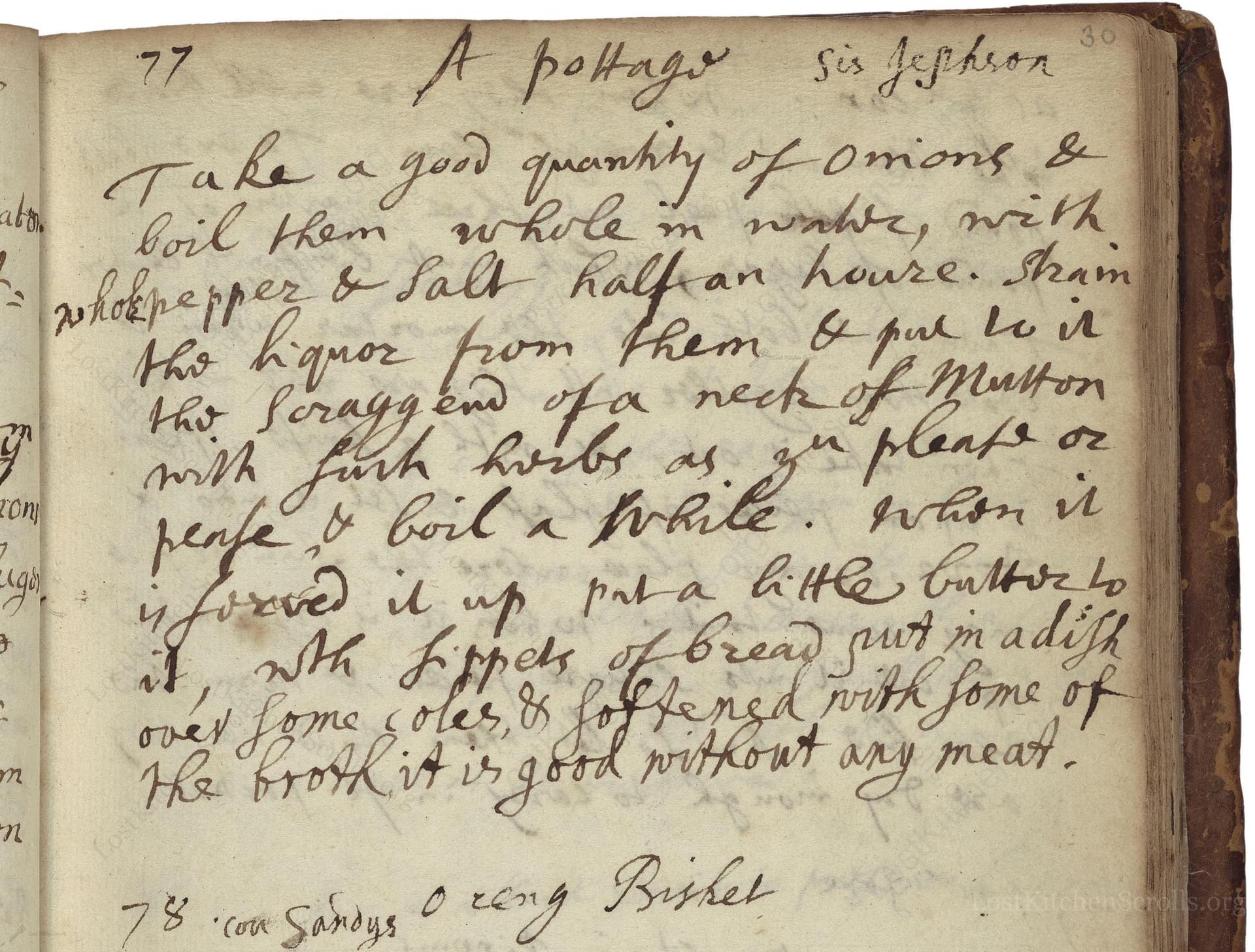A Pottage
From the treasured pages of Receipt book of Penelope Jephson
Written by Penelope Patrick

A Pottage
"77 A pottage Sir Jephson Take a good quantity of Onions & boil them whole in water, with wholepepper & Salt halfe an houre. Strain the liquor from them & put to it the scragg end of a neck of Mutton with such herbes as you please or perfse & boil a while. when it is served it up put a little butterr to it, wth sippets of bread put in a dish ouer some coles, & softened with some of the broth. it is good without any meat."
Note on the Original Text
This recipe is written in the style of Restoration England, marked by minimal punctuation and idiosyncratic spelling (e.g., 'liquor' for broth, 'wth' for 'with', 'herbes as you please'). Quantities and timings are approximated or omitted, reflecting the expectation that cooks possessed hands-on familiarity with ingredients and processes. The instruction 'it is good without any meat' shows the adaptable, use-what's-available philosophy and reflects the text’s engaging practicality for both meat-eaters and vegetarians of the age.

Title
Receipt book of Penelope Jephson (1673)
You can also click the book image above to peruse the original tome
Writer
Penelope Patrick
Era
1673
Publisher
Unknown
Background
Step back into the sumptuous kitchens of the late 17th century with Penelope Patrick’s culinary collection—a feast of historic recipes, secret tips, and the irresistible flavors of Restoration England all bound together in a handwritten treasure.
Kindly made available by
Folger Shakespeare Library
This recipe was recorded between 1671 and 1675 by Penelope Patrick, an English gentlewoman from the Restoration period. 'A pottage' like this would have been a staple on English tables, enjoyed by both the gentry and commoners, though the use of mutton and plentiful herbs suggests a moderately prosperous household. Broths and pottages were a foundation of early modern English diet, providing nourishment and warmth, and were often adaptable depending on available ingredients. This particular recipe offers flexibility; meat can be omitted, enabling the dish to serve fasting days or support more modest resources.

Cooks in the late 17th century would have used earthenware or heavy iron pots over an open hearth, suspended on hooks or placed on trivets above the fire. A knife and wooden board would be used to peel and trim onions and herbs, and a sieve or cloth for straining, although a slotted spoon may have sufficed. Sippets (slices) of bread would be cut with a bread knife, and dishes would be warmed over the residual coals of the hearth.
Prep Time
10 mins
Cook Time
1 hr 15 mins
Servings
4
We've done our best to adapt this historical recipe for modern kitchens, but some details may still need refinement. We warmly welcome feedback from fellow cooks and culinary historians — your insights support the entire community!
Ingredients
- 14 oz small onions, peeled and trimmed
- 5 cups water
- 1 tablespoon (about 0.35 oz) whole black peppercorns
- 2 teaspoons (about 0.35 oz) salt
- 18 oz mutton neck (or lamb neck as substitute)
- 0.7 oz fresh parsley
- 0.7 oz fresh thyme (or other herbs of your choice, such as marjoram or savory)
- 0.5 oz (1 tablespoon) salted butter
- 4–6 thick slices (about 5.3 oz) day-old rustic bread
Instructions
- To prepare this 17th-century pottage, start by peeling and trimming about 14 oz of small onions.
- Place them whole into a large pot with 5 cups of water, add 1 tablespoon of whole black peppercorns and 2 teaspoons of salt.
- Boil gently for 30 minutes.
- Strain out the onions, reserving the savory broth.
- Add approximately 18 oz of mutton neck (or substitute with lamb neck if mutton is unavailable) to the strained broth, along with fresh herbs of your choice—such as a small handful (about 0.7 oz each) of parsley and thyme.
- Simmer until the meat is cooked and the broth is flavorful, about 45 minutes more.
- To serve, melt a tablespoon (about 0.5 oz) of butter into the hot broth.
- Ladle the broth over slices of stale bread placed in serving bowls or a dish set over coals, allowing the bread to soften in the broth.
- The stew may be enjoyed with or without the meat, making it suitable as a hearty vegetarian dish as well.
Estimated Calories
320 per serving
Cooking Estimates
You will need about 10 minutes to prepare the vegetables and meat, and around 1 hour and 15 minutes to cook the dish. Each serving has roughly 320 calories. This recipe makes 4 servings.
As noted above, we have made our best effort to translate and adapt this historical recipe for modern kitchens, taking into account ingredients nowadays, cooking techniques, measurements, and so on. However, historical recipes often contain assumptions that require interpretation.
We'd love for anyone to help improve these adaptations. Community contributions are highly welcome. If you have suggestions, corrections, or cooking tips based on your experience with this recipe, please share them below.
Join the Discussion
Rate This Recipe
Dietary Preference
Main Ingredients
Occasions

Den Bockfisch In Einer Fleisch Suppen Zu Kochen
This recipe hails from a German manuscript cookbook compiled in 1696, a time whe...

Die Grieß Nudlen Zumachen
This recipe comes from a rather mysterious manuscript cookbook, penned anonymous...

Ein Boudain
This recipe comes from an anonymous German-language manuscript cookbook from 169...

Ein Gesaltzen Citroni
This recipe, dating from 1696, comes from an extensive anonymous German cookbook...
Browse our complete collection of time-honored recipes



